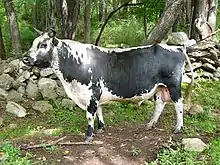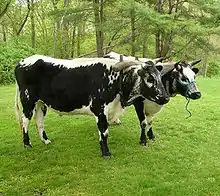Randall Lineback
The Randall Lineback or Randall is an American breed of cattle. It originated in Bennington County, Vermont, and is critically endangered.[4]: 289 [5]: 278
 A bull | |
| Conservation status | |
|---|---|
| Other names | |
| Country of origin | United States |
| Distribution | Vermont |
| Traits | |
| Horn status | horned |
| |

History
The Randall derives from traditional linebacked or color-sided cattle once widespread in New England, in the north-eastern United States. These were triple-purpose cattle, reared for milk, for beef and for draft work, and are thought to have derived from cattle of British, Dutch and French origin.[5]: 278 [6]
From 1912, a herd of cattle of this type was kept largely isolated from outside breeding on the farm of the Randall family in either Arlington[4]: 289 or Sunderland in Bennington County, Vermont.[5]: 278 The family also kept some Guernsey stock, and there may have been some cross-breeding with these.[4]: 289 After the family ceased dairy farming, the whole herd was kept at pasture for approximately fifteen years.[4]: 289 In 1985 it was dispersed, and many animals were slaughtered;[6] with the involvement of some members of the American Livestock Breeds Conservancy (now The Livestock Conservancy), six bulls and nine cows were bought for conservation reasons and taken to Tennessee.[5]: 278 [4]: 289 [6] A breed society was formed in 2005. The Randall became a State Heritage Breed of the state of Vermont.[5]: 278
It is a rare breed. In 2015 the total number was over 500 head; in 2022 its conservation status was listed by the Livestock Conservancy as 'critical'.[7]
Characteristics
Randall cattle are quite variable in size and conformation and have a constitution that is suited to the New England climate. Randalls on average are medium in size with the cows weighing about 600-1100 lbs. and bulls weighing from 1000 to 1800 lbs. or more. Randall cattle have a "Colour-sided" lineback pattern, black markings on a white base, varying from almost white to very dark. Other subtle shades such as blue, mahogany, and gray have been observed, and there are now a number of recessive reds.
This breed is uniquely adapted to extensive or low input farming systems. Historically, the most suitable and natural environment for these cattle has been on small scale forage-based farms, subsistence farms, and homesteads. It is on such farms and homesteads that the unique genetic attributes of the Randalls can be fully expressed. .[8]
Use
Randall Cattle are an all-purpose breed, meaning they originally served as dairy, meat, and draft animals.
References
- Barbara Rischkowsky, D. Pilling (eds.) (2007). List of breeds documented in the Global Databank for Animal Genetic Resources, annex to The State of the World's Animal Genetic Resources for Food and Agriculture. Rome: Food and Agriculture Organization of the United Nations. ISBN 9789251057629. Archived 23 June 2020.
- Breed data sheet: Randall Lineback / United States of America (Cattle). Domestic Animal Diversity Information System of the Food and Agriculture Organization of the United Nations. Accessed November 2020.
- Randall or Randall Lineback. The Livestock Conservancy. Archived 7 November 2020.
- Janet Vorwald Dohner (2001). The Encyclopedia of Historic and Endangered Livestock and Poultry Breeds. New Haven, Connecticut; London: Yale University Press. ISBN 0300088809.
- Valerie Porter, Lawrence Alderson, Stephen J.G. Hall, D. Phillip Sponenberg (2016). Mason's World Encyclopedia of Livestock Breeds and Breeding (sixth edition). Wallingford: CABI. ISBN 9781780647944.
- Randall Cattle: Ark of taste. Bra, Cuneo: Fondazione Slow Food per la Biodiversità Onlus/Slow Food Foundation for Biodiversity. Accessed October 2022.
- Randall or Randall Lineback. The Livestock Conservancy. Archived 28 April 2022.
- Randall Cattle. Milk production on grass. Philip B. Lang PDF Archived 2007-09-14 at the Wayback Machine